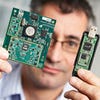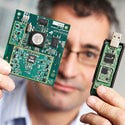November 13, 2013

Just as operators around the world are launching 4G, it is salutary to be reminded of how much work still needs to be done.
Ten years on from the launch of 3G in the UK, regulator Ofcom announced that only three of the four networks met the bar of 90 percent outdoor population coverage. (See Euronews: Ofcom Slams Vodafone's 3G.)
As Olaf Swantee, CEO of EE remarked at a recent industry event, "3G didn't live up to its promise or investments." The consequence of those failings is evident in Ofcom's announcement. Even hitting the 90 percent target means 6 million people in the UK cannot get 3G -- equivalent to the whole population of Scotland.
Other countries have stricter requirements: Orange France claimed 98.5 percent population coverage last year and SFR is aiming for 99.3 percent of the populace by the end of 2013. And that is in a country far bigger and more sparsely populated than the UK. Many Asian countries have had 99 percent coverage for some years.
Given the huge importance of telecom and mobile Internet to the economy, having millions of people who cannot access mobile Internet is a substantial missed opportunity. Research by GSM Association (GSMA) suggests that increasing 3G penetration by 10 percent in a developed country is worth 0.15 percent to GDP.
So if the UK's 3G coverage were as good as France's, the economy would be richer by $3.5 billion a year. What's more, this gain would be concentrated in those areas that can't get coverage -- often precisely the poorer rural regions that most need economic growth.
The questions we need to ask are: What can we do to make sure 4G is done better; and are there things we can do to improve 3G in the meantime? These may be especially topical in UK, but, of course, the same issues apply in all countries. The 90 percent figure is for outdoor coverage and reflects places where there just is no 3G service. Indoor coverage is a slightly different problem, though probably more important, more valuable and getting worse thanks to energy efficient buildings.
But, with small cells, it is a problem that can easily be solved, provided you have an adequate fixed broadband connection running to your small cell.
Obviously, the more people you try to cover, the harder (and the more expensive) it is to reach them. Those last few percent live in rural areas, with low population densities where backhaul connectivity is rare and expensive to install. Some people live in remote islands or hard-to-reach spots. As EE's Swantee put it: "Hills and leaves and villages in valleys are a connectivity challenge in UK."
Covering the first 80 percent of the population might be relatively easy, but going from 80 percent to 90 percent will be tougher, and from 90 percent to 99 percent harder still. And so it goes -- harder and harder, more and more expensive to reach those last few people.
But other countries have proved that not only can it be done, it can be done cost-effectively.
Real Wireless has practical insight in this regard. As part of the 4G auction planning, the independent advisory firm prepared a comprehensive model of the UK, with detailed analysis of population, geography (to allow for those islands and valleys), and the technologies, from 2G to 3G, 4G and beyond, for both macrocells and small cells. It also applied these techniques to help other countries set challenging but economically achievable coverage targets.
Models such as these (others produce them too) allow regulators and operators to predict the capex and opex implications for a given level of population coverage, whether 80 percent or 99.9 percent. They can also go well beyond basic coverage and predict the capacity and performance issues that dictate the actual mobile broadband experience.
We do see encouraging signs: Network cooperation between operators allows them to get to more basestation sites, faster and more cost-effectively. The availability of lower-frequency spectrum allows those sites to reach further and penetrate deeper into buildings. The cost of basestations has dropped steeply, while smaller, lighter systems are easier and cheaper to deploy. Backhaul is a challenge in these more remote rural areas, but high-capacity, cost-effective wireless links are now widely available.
Finally, the advent of small cells has the potential to transform network economics: Although often thought of as tools for urban areas, they can also deliver service to rural areas, where their lower costs make deployment profitable even for low population densities -- "meadow cells" as contrasted to the more familiar metro cells!
If the right decisions are made, supported by the right analysis, we believe that the next few years of deploying LTE are an opportunity to transform network rollout from the "thin and crispy" approach that characterized initial 3G deployment to a "deep pan" 4G experience.
Of course, although this is based on Ofcom and the UK, the principles apply more generally. If we get this right, we can ensure that in five years we, as an industry, have transformed coverage and access to mobile Internet in countries all over the world.
— Rupert Baines, Chief Marketing Officer, Real Wireless
Read more about:
EuropeAbout the Author(s)
You May Also Like











